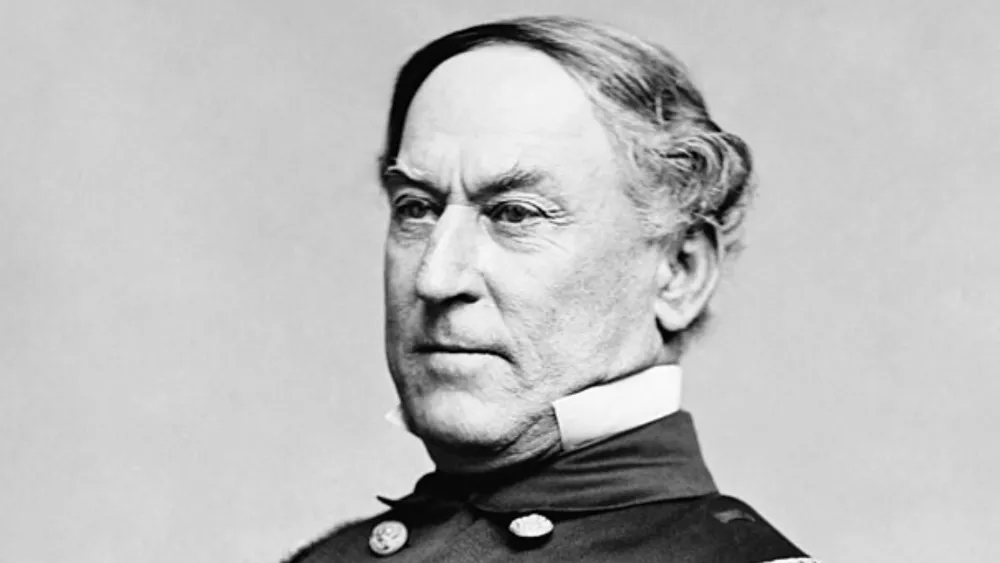Admiral David Glasgow Farragut is a towering figure in American history. He dedicated his entire life to serving in the U.S. Navy. Born as James Glasgow Farragut on July 5, 1801, near Knoxville, Tennessee, he would later undergo a significant name change when he came under the guardianship of Captain David Porter. Under this new identity, David Glasgow Farragut would etch his name into the annals of history. He became a civil war hero renowned for his exceptional courage at the Battle of Mobile Bay.
The expertise of the North’s naval commanders played a vital role in the Union’s victory at Vicksburg. David Glasgow Farragut was one of the Civil War’s most flamboyant naval captains. Even though Farragut’s early naval efforts against Vicksburg were unsuccessful, his victories at New Orleans and Mobile Bay cemented his reputation as one of America’s most beloved heroes. On July 6, 1801, James Glasgow Farragut, who would go on to become the first Admiral of the United States Navy, was born near Knoxville, Tennessee. His father, Jorge Farragut, was from a family of seafarers who immigrated to this nation in 1776 from Minorca, an island off the east coast of Spain.
From Minorcan Origins to American Beginnings
James Glasgow Farragut was born on July 5, 1801, to George (Jorge) and Elizabeth Shine Farragut. His commercial seaman father, Jorge Antonio Farragut-Mesquida, was born in 1755 on the Spanish island of Minorca. Jorge and David Farragut descend from Don Pedro Farragut. He is a 13th-century conqueror who served the King of Aragon in eastern Spain.
George Farragut moved to North America in 1776 and fought as a naval officer in the American Revolutionary War after serving in the Spanish Merchant Navy. He served in the Continental Navy after serving with the South Carolina Navy. After serving in the Revolution, George and Elizabeth went to Tennessee, where he ran Lowe’s Ferry and was a cavalry lieutenant in the Tennessee militia.
David Farragut and his Early Naval Adventures
When Farragut was young, Captain (later Commodore) David Porter (of the U.S. Navy), who adopted him, became his buddy. During the War of 1812, Farragut worked alongside Porter on board the frigate Essex. It amassed so many British whaling ships that Farragut, 12 at the time, was given command of one of the prize ships. By the time he was 20, he was an experienced ship officer. In 1823, he worked with Porter in a fleet that subdued Caribbean pirates. In 1824, he received his first autonomous command.
After several years of regular duty, Farragut commanded the squadron in the western Gulf of Mexico in December 1861. He was ordered to enter the Mississippi River and seize New Orleans, a port where the South got most of its war supplies from outside. Moreover, he successfully executed his audacious plan. He charged through them with cannons blazing in the nighttime on April 24, 1862, against the War Department’s advice. The department had suggested first demolishing the two defenses that lay some distance downstream of the city by mortar bombardment.
A Child of the Sea: Farragut’s War of 1812
When Farragut joined the U.S. Navy, his naval career officially began. “Boy” was listed on the Navy’s rolls in the spring of 1810. Farragut was granted a midshipman’s position in the U.S. Navy on December 17, 1810, when he was nine years old, thanks to the influence of his foster father. So, by age 11, Farragut was a prize master and served under his foster father, Captain Porter, in the War of 1812. Farragut took part in the capture of HMS Alert while stationed with the USS Essex frigate.
Farragut’s Tenacity Amidst Adversity
In 1847, Farragut took command of the USS Saratoga as a commander. The ship underwent recommissioning at the Norfolk Navy Yard in Norfolk, Virginia, at that time. Farragut, commanding, steered the USS Saratoga out of Norfolk on March 29, 1847, bound for the Gulf of Mexico. Furthermore, It received orders to join the Home Squadron for Mexican-American War duty.
On April 26, 1847, the Saratoga reached Veracruz, Mexico, and reported to Commodore Matthew C. Perry, the squadron’s commander. Farragut and Saratoga resumed their blockade duties at Tuxpan on September 1, 1847, and stayed there for two months despite an epidemic of yellow fever on board.
After a month at Veracruz, Farragut sailed the ship back to Florida’s Pensacola Navy Yard, where the Saratoga arrived on January 6, 1848. Furthermore, she unloaded all her critically ill patients at the base hospital and restocked her supplies there. Farragut left Pensacola on a ship on January 31, 1848. Afterward, he arrived in New York City on February 19. On February 26, 1848, Saratoga was taken out of service there.

The Final Voyage of David G. Farragut
While on vacation in late summer 1870 in Portsmouth, New Hampshire, Farragut passed away from a heart attack at 69. He has over 60 years of Navy service. He rests in The Bronx, within New York City’s Woodlawn Cemetery, which holds recognition as a National Register of Historic Places entry, along with his grave. They named Farragut Square in the capital city after him. It is a perpetual ode to the most illustrious naval officer of the American Civil War.
The Farragut West and North Metro stations in Washington also share his name. A statue of Admiral Farragut is located Nearby at Castle Island at South Boston Marine Park. Farragut’s lavish burial publicized the brand-new Woodlawn Cemetery, established in 1863, and his monument established the early benchmark for the cemetery’s memorial design. Also, the best-preserved property directly connected to the first rear admiral, vice admiral, and four-star admiral in American history is now Farragut’s burial on Aurora Hill. Moreover, the significance of Woodlawn Cemetery in terms of constructed architecture and art makes it a National Historic Landmark.










